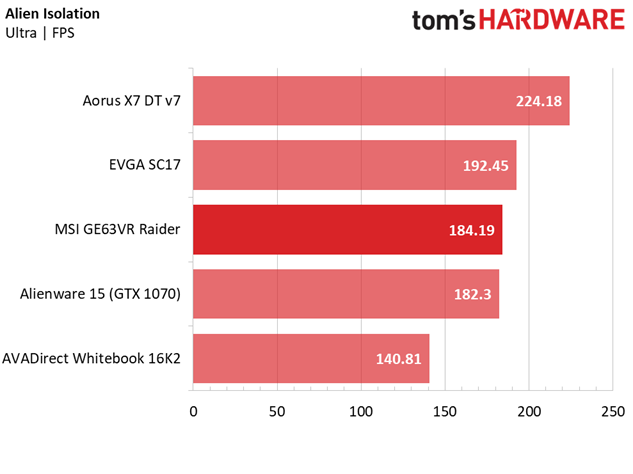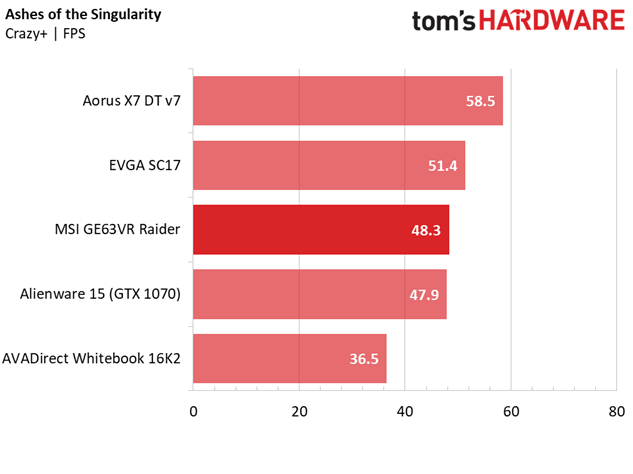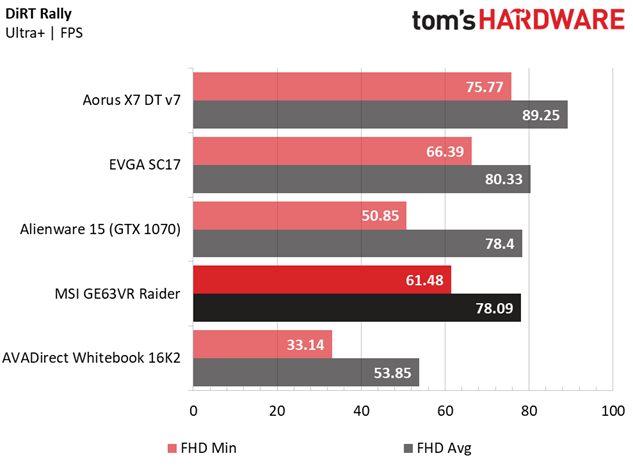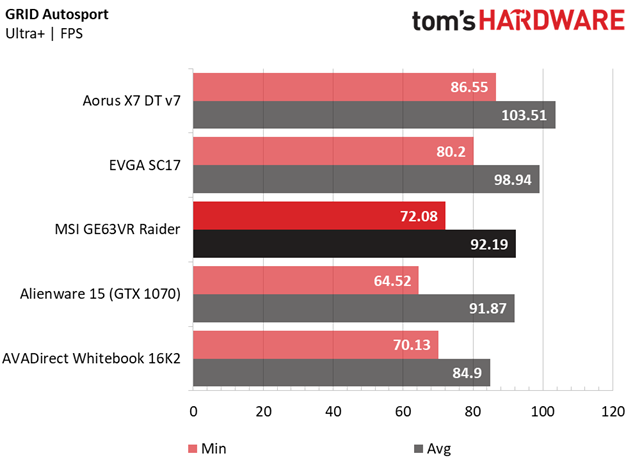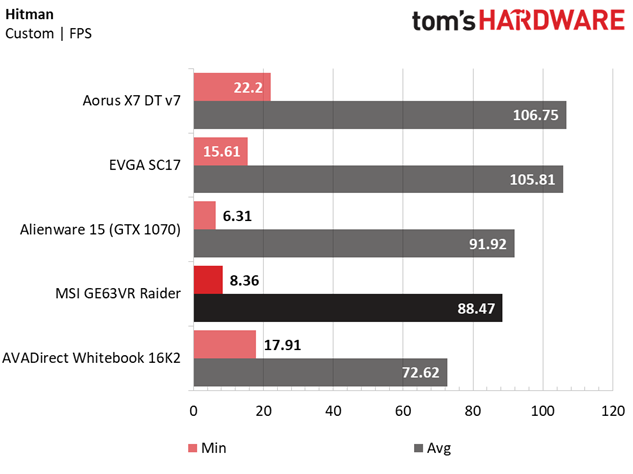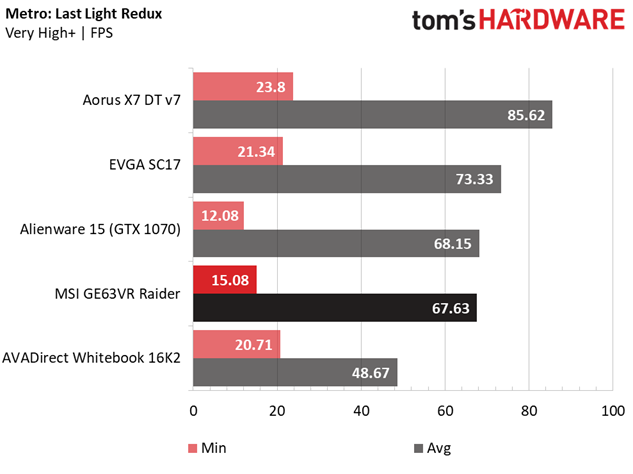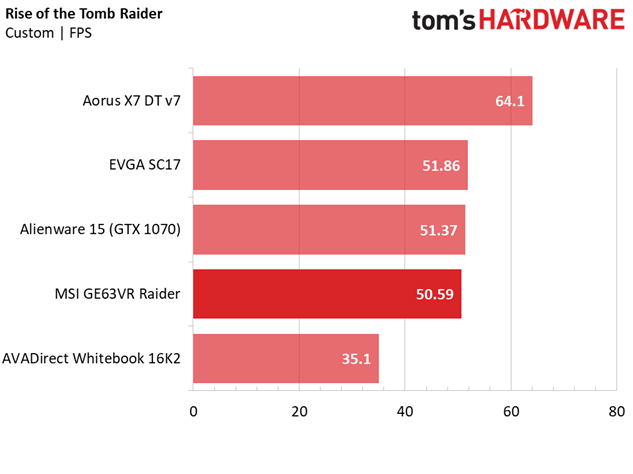MSI GE63VR Raider Gaming Laptop Review
Why you can trust Tom's Hardware
Gaming Benchmarks
Alien: Isolation
If our 3DMark and CompuBench scores were any indication, it should come as no surprise that the MSI GE63VR Raider and Alienware 15 produce the same level of performance here. However, the EVGA SC17, whose older CPU consistently placed it lower than the Raider and Alienware laptops in our synthetic benchmarks, rises to the occasion in Alien: Isolation, scoring 4% higher than the Raider.
Ashes of the Singularity
Ashes of the Singularity is a fairly strenuous game, and even the powerful GTX 1070 can’t quite deliver 60 FPS consistently. However, it does come fairly close; the Raider maintains an average of 48 FPS, and 60 is easily achievable by reducing some of the settings. The MSI and the Alienware laptops again deliver similar performance, and the EVGA performs just slightly better thanks to its CPU.
If you don’t want any compromise your graphical settings, you can step up to the Aorus, which comes just a frame-and-a-half shy of 60 FPS. On the other hand, if you’re strapped for cash and you don’t mind reducing your settings, you can opt for a laptop with a GTX 1060. The AVADirect performs 24% slower than the MSI, but still delivers playable frame rates.
DiRT Rally
DiRT Rally relies a bit more on overall platform strength. The Whitebook 16K2 delivers 53 FPS with just a GTX 1060, and light tweaking is all that’s needed to reach 60 FPS. However, A GTX 1070 provides a substantial performance increase, with both the Raider and the Alienware 15 delivering 32% higher frame rates. The SC17 only provides a couple additional FPS, and the X7 outperforms the field by 14%.
Grand Theft Auto V
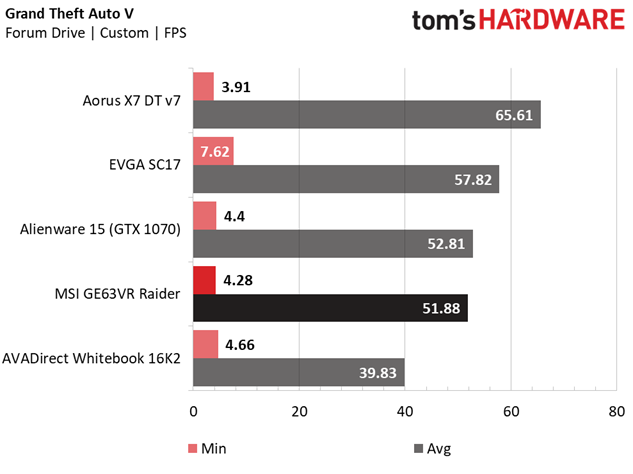
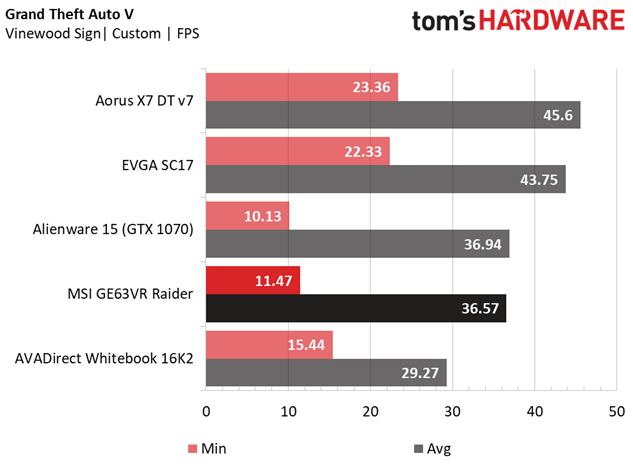

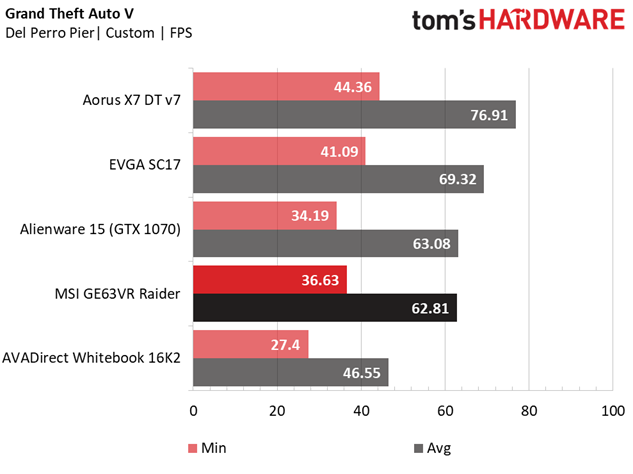
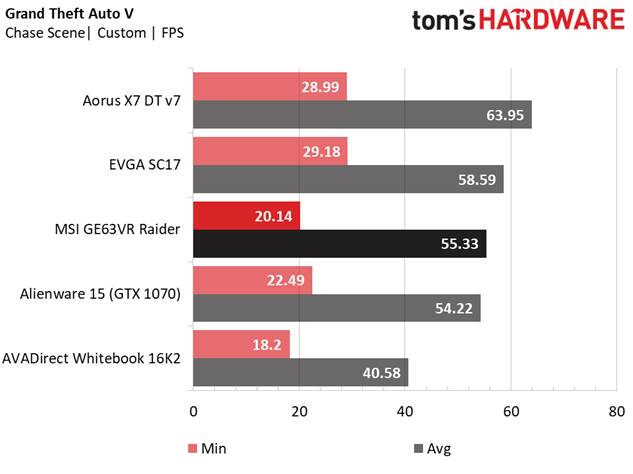
Grand Theft Auto V ups the ante with a handful of benchmark scenes, each with its own level of intensity. The GTX 1070 proves to be more than a match for most of these, delivering at least 50 FPS across the board and even hitting 60 FPS in the Del Perro Pier scene.
The Vinewood Sign scene, however, is notorious for bringing systems to their knees; the MSI Raider maintains 36 FPS, which some would consider barely playable. Even the more adequately equipped Aorus only delivers 9 more FPS. Interestingly, the EVGA SC17 creates an impressive performance gap over most of the comparison set with its i7-6820HK alone. The gap between the SC17 and Aorus is only a couple of frames in this scene.
GRID Autosport
GRID Autosport features a light platform-based workload, and any modern system should be able to maintain a solid frame rate here. Gamers can rest easy knowing that the GTX 1070 holds its own, and the Raider dominates GRID’s benchmark. A more powerful laptop, such as the X7, offers 12% additional performance, but this only amounts to about 11 FPS.
Get Tom's Hardware's best news and in-depth reviews, straight to your inbox.
One of GRID’s quirks is that GPUs with higher clock rates are given a slight edge, so the Whitebook 16K2 comes dangerously close to the Raider’s score, delivering only about 8% less performance, but still in excess of 60 FPS.
Hitman
Hitman offers a level of graphical intensity similar to GRID Autosport, but instead of prioritizing GPU clock rate, it factors in CPU power. The GE63 Raider performs admirably yet again, delivering just under 90 FPS and matching the Alienware 15. Unfortunately for the AVADirect, there’s a much larger 18% performance gap here.
However, the EVGA SC17 outperforms the Raider by a considerable 20% margin, thanks to the might of its CPU. Comparatively, the Aorus X7 only eeks out one more frame than the SC17.
Metro: Last Light Redux
Metro: Last Light Redux is the first in a line of particularly GPU-intensive titles; it’s not as taxing as RoTR, but it still provides modern gaming laptops with a considerable challenge. The Whitebook 16K2’s frame rate drops below 50 FPS. To achieve 60 FPS without reducing settings, you’ll need a laptop with at least a GTX 1070, as seen by the performance of the MSI Raider and Alienware 15 systems.
Rise of the Tomb Raider
Rise of the Tomb Raider is an even better example of GPU priority, and here we witness the MSI, Alienware, and EVGA delivering essentially the same performance. The Aorus is the only laptop in the roundup that can reliably deliver 60 FPS, outperforming the other systems by about 27%. 50 FPS isn’t bad, and you can easily reach 60 FPS by dialing down demanding settings such as anti-aliasing.
The Division
Although The Division is GPU-reliant, it isn’t as taxing on your system as Rise of the Tomb Raider or Grand Theft Auto V. Because of this, the GTX 1070 laptops easily reach the 60 FPS threshold with quite a bit of performance to spare. In this case, the SC17’s more powerful processor offers virtually no performance benefit, losing out to the Raider by a few frames.
The Aorus offers an additional 23% performance because of its GTX 1080. Downgrading to a GTX 1060 will plunge your frame rate below 60 FPS, but this can be remedied by turning a few settings down.
Thief
Thief is much easier to render than the last few titles, so gamers can crank the settings to max without worry. A laptop with at least a GTX 1060 can easily handle 60 FPS, while GTX 1070 laptops such as the MSI Raider fall in the 100 FPS ballpark. This doesn’t quite reach the Raider’s 120Hz refresh rate. The Aorus X7 DT v7 has a GTX 1080, so it can reach 120 FPS with less tweaking than MSI's Raider.
MORE: Best Gaming Laptops
MORE: Gaming Laptop Previews
MORE: All Laptop Content
Current page: Gaming Benchmarks
Prev Page Synthetic Benchmarks Next Page Battery, Thermal & Display Testing-
sammseven Great and very complete review!Reply
I'll buy this laptop, since I can find it for 1700€ in my country with the 16gb RAM and 1070 graphics.
Thank you for this great job in this review! -
Ninjawithagun Definitely a much better hardware layout compared to my Asus G701VI-XS72K, and is therefore much easier to upgrade components. But as far as performance, my G701V still destroys the MSI GE63VR. I paid just $2165 for my laptop and it has a GTX1080 and a 120Hz G-Sync screen. The MSI GE63VR only has a GTX1070 and 120Hz display with no G-Sync. I suppose it's tid-for-tad on what the individual consumer wants to spend vs. what they get and how easy it is to upgrade in the future.Reply -
ledhead11 I have to totally agree Ninjawithagun. I think I read about the release of that Asus about a year ago and thought. . .finally a perfect match. Agreed, a bit high on the price but the GPU/Display match is perfect. Looking at these benchmarks for the 1070, ultra settings are a near disaster for demanding games and tearing will be inevitable. They really should've had a g-sync to at least compensate.Reply
The nice thing too about that Asus is that it will hold its own for years to come for 1080p gaming while present day games can start to pull down a 1070 from even hitting 80fps let alone 120fps.
At this point MSI is more about marketing hype and jacking prices than performance. Like many they throw the 'gaming laptop' and state CPU/Ram specs then try to shine how they've consistently mismatched their displays and gpus. A good example are how many of their sli rigs were matched with 1080/60hz before they even began to intro something else.
Honestly, sammseven, if you're truly looking into getting something like this then look a little higher at someting like that Asus. There's a reason the MSI was at the near bottom for most of these benches and I do agree this is a good review too. -
darth_adversor Just my opinion, but I think $2,300 is an astronomical amount of money to spend on a gaming laptop. For that much money, it shouldn't have any major deficits, and yet, no G-Sync?Reply
Honestly, it still wouldn't be a great buy even with G-sync, as you can get into a 1080 for about the same price, but come on... -
JAVI LIP I'm really angry at MSI. I bought a laptop GE60 2PL three years ago and the motherboard has failed. I had a laptop from other vendor and I didn't have any trouble for 11 years.Reply -
sillysoft Back in 2013 I bought my very first laptop, it was a MSI G Series GT70 2OD-039US. I still use it to this day, Im on it right now. Im in the market for a new laptop though, all I can say is I wont be buying another MSI laptop. Though its lasted, I treated this laptop VERY well and it still broke on me. The keyboard broke, keys just stopped working, plastic broke off around the lid. The metal bars that allow the lid to open and close is exposed. I now have a external monitor on top of a stand with the laptop close with external KB/M, basically I use it as a desktop now. But it looked pretty cool at the time and the specs also looked "beefy". But I will never buy another laptop or desktop again without consulting with others first. Cant trust myself to make good decisions on this topic lolReply
Speaking of which, any suggestions on a new loaded laptop for $3k or less? Looking at the Asus G701VI-XS72K. -
ledhead11 I too had a bad MSI laptop experience. I went all in for a GT80 Titan 980mSLI. I got it through a re-seller with some upgrades that resulted in about a years worth of grief. Eventually I learned how to deal with the unique design of it and did my own upgrades after. It's been fine since but honestly at this point I'd never recommend another MSI laptop again. Their desktop stuff is great, otherwise-no.Reply
@sillysoft IDK if a TI mobile will be coming out or if one would happen below $3k. If it did I'd look at something like that. Otherwise, that Asus looks pretty solid. Hard thing is that there aren't many reviews for the 1080p/120hz/G-Syncs w/ 1080 GPU's. The 1070 ones are everywhere but pretty much useless for the money.
